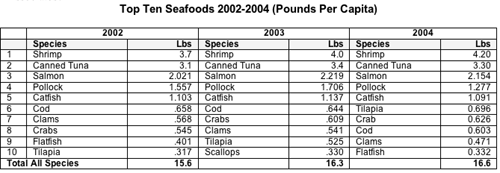 Americans Eating More Seafood By Laine Welch November 14, 2005
According to the annual "Fisheries of the United States" report by NOAA Fisheries, each American ate a record 16.6 pounds of seafood last year, up from 16.3 pounds in 2003. (That compares to 14.8 pounds in 2001.) Each person enjoyed nearly 12 pounds of fresh and/or frozen seafood (another record), reflecting a continuing trend towards those products, while consumption of canned seafood dropped slightly to 4.5 pounds per person. In all, Americans enjoyed 4.85 billion pounds of seafood in 2004 (another record). Although U.S. seafood consumption has increased for the third year in a row, Americans are still eating far too little to get the health benefits derived from fish. The 16.6 pounds per person breaks down to just five ounces per week, less than half of what health professionals recommend. America's favorites remained largely the same, with farmed tilapia showing the biggest gains. Here is the Top Ten List compiled for the National Fisheries Institute by H.M. Johnson & Associates: 
An interesting quote on Americans eating more seafood by Bill Hogarth, director of NOAA Fisheries: "Seafood is a safe and healthy food choice for all Americans and, as this trend shows, the demand keeps rising. The Administration's National Offshore Aquaculture bill is one way to meet this demand with seafood that is either harvested or grown right here in the United States." MORE FISH AT FAST FOOD - Americans want more seafood at their favorite eateries, and they prefer that it comes from Alaska. Those were some of the findings in a survey of more than 1,000 Americans by the San Francisco based Hale Group. The survey, conducted for the Alaska Seafood Marketing Institute, measured attitudes toward seafood at fast food and casual dining restaurants, and asked customers to rank popular brand names that would influence their ordering decisions. "We definitely found out that consumers are looking for more seafood selections and they are very positive about Alaska seafood," said Claudia Hogue, ASMI Food Service director. In fact, respondents said the Alaska logo would increase their likelihood of ordering a seafood item by 77 percent. In other findings: 58 percent said they are eating more seafood than they did two years ago, mostly due to the health benefits (64 percent). Fully half of those polled said they are trying to eat less beef, pork and chicken. Sixty percent said they eat most of their seafood in restaurants. Eighty five percent said Alaska salmon is a great source of omega three fatty acids, 84 percent said Alaska seafood comes from clean, pure waters and 79 percent said it was wild. Other words used to describe Alaska seafood included natural, pure, and high quality. Interestingly 41 percent felt Alaska seafood was endangered. Those polled were happier with the seafood choices at casual restaurants than at fast food eateries. A whopping 81 percent said they want more seafood options at fast food restaurants, notably grilled fish items. "Healthy menu items is a big topic, and the more seafood choices the better," Hogue said, adding that ASMI will provide the survey information to restaurant chains and other users. "We're hoping this will help decision makers add more Alaska seafood to their menus and promote it as Alaska, because it really means something to consumers," she said. Find the consumer preferences survey at www.alaskaseafood.org. FIND YOUR VOICE - "Managing Fisheries, Empowering Communities" was the focus of a three day conference earlier this year. It brought together a diverse group of fishermen, policy makers and social scientists from as far away as Rome and Canada to discuss one thing: how to increase understanding and give local communities more of a voice before new fisheries management decisions are made. Alaska Sea Grant has published the findings and they make for a great read. For example, a look at demographics and trends in fishing crews reveals that 272,000 licenses were issued from 1993 to 2003, and the total annual crew member population decreased by about 50 percent during the decade, from a high of over 30,000. Men made up 86 percent of all license holders, with an average age of 30.2. Anchorage, Kodiak and Seattle consistently rank as the top three home communities for crew members. Find the 100 page book for $10 at the Sea Grant Book store at www.alaskaseagrant.org . BOOK SALES HELP HURRICANE VICTIMS-
On a related note, from now through April the Alaska Sea Grant
book store will donate 10 percent of all sales to AFIRM, the
Alaska Fishing Industry Relief Mission, a non profit charity
that was established by members of Alaska's seafood industry
to help their Gulf Coast counterparts hurt by recent hurricanes.
"Alaska and the Gulf Coast are the two most productive sources
of wild seafood in the U.S.," said Senator Lisa Murkowski,
AFIRM honorary chair. "We have much more in common than
in competition. We believe that anything that weakens the domestic
seafood industry weakens the economic and social fabric of both
our regions." Order at www.alaskaseagrant.org
or call 888-784-0090 for a catalog of books, videos, calendars,
posters, games and teaching aides. Questions? Contact Kathy Kurtenbach
at 907-474-7476 or k.kurtenbach@uaf.edu.
Publish A Letter on SitNews Read Letters/Opinions Submit A Letter to the Editor
|